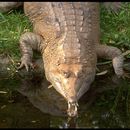Biology
provided by Arkive
Very little is known about the ecology of this species. Females appear to construct mound-nests of dry leaves and peat onto which an average of 20 to 30 large eggs are laid (2). Unusually amongst crocodilians, there is no direct evidence that hatchlings receive any parental care and consequently mortality is thought to be high (2).
The slender snout is well adapted for catching fish but the false gharial exhibits a more generalised diet; also eating insects, crustaceans and small mammals (2).
Conservation
provided by Arkive
International trade in the false gharial is prevented by its listing on Appendix I of the Convention on International Trade in Endangered Species (CITES) (1), and many of the known populations occur within protected areas (3). Recent population estimates of the false gharial are under 2,500 mature adults but data on distribution is still insufficient (2). Before a successful conservation management plan can be implemented more information needs to be collected on the current status of this species in Malaysia and Indonesia. Further research into behaviour and ecology must be carried out in order to identify priority habitats and population needs (3). A Tomistoma Task Force has recently been set up under the umbrella of the IUCN-SSC Crocodile Specialist Group (5).
Description
provided by Arkive
The false gharial is an unusual freshwater crocodilian (a group that includes alligators, crocodiles, caimans and the gharial) about which very little is known. Like the gharial (Gavialis gangeticus) from which it gets its common name, this species has a slender snout (2). Juveniles are dark/chocolate brown with black banding on the tail and body, a creamy white belly and dark blotches on the jaws; much of this colouration is retained into adulthood (2). Controversy over the taxonomy of this species remains, as morphological features (other than the snout shape) suggest it belongs in the family Crocodylidae where it is currently placed, but recent biochemical and immunological evidence suggests a closer relationship with the gharial, indicating it should also be placed in the family Gavialidae (3).
Habitat
provided by Arkive
Inhabits freshwater swamps, rivers and lakes, preferring slow-moving water and heavily vegetated habitats (2).
Range
provided by Arkive
Historically found in South East Asia throughout the Malay Peninsula and also on Sumatra and Borneo (3). Today the false gharial appears to be extinct in Thailand and is seen only at low densities (although populations are widespread) in Malaysia and Indonesia (3). There are unconfirmed reports of sightings in Vietnam and Sulawesi (3).
Status
provided by Arkive
Classified as Endangered (EN - C1) on the IUCN Red List 2002 (1), and listed on Appendix I of CITES (4).
Threats
provided by Arkive
Habitat destruction caused by the construction of dams, channelling and deforestation amongst others has been the main cause of the decline of this species and continues to be its main threat to this day (3). Intensive hunting in some areas, especially Sumatra, in the mid 20th Century also contributed greatly to the decline in population numbers (3). Further threats come from fishing practices, with false gharials either becoming caught in nets, poisoned by toxins used to kill fish, or else loosing their food source to local fishermen (2).

